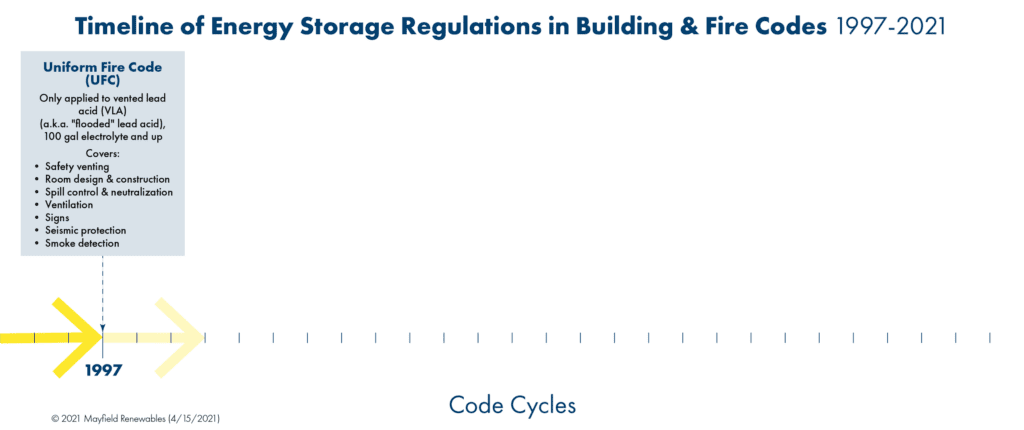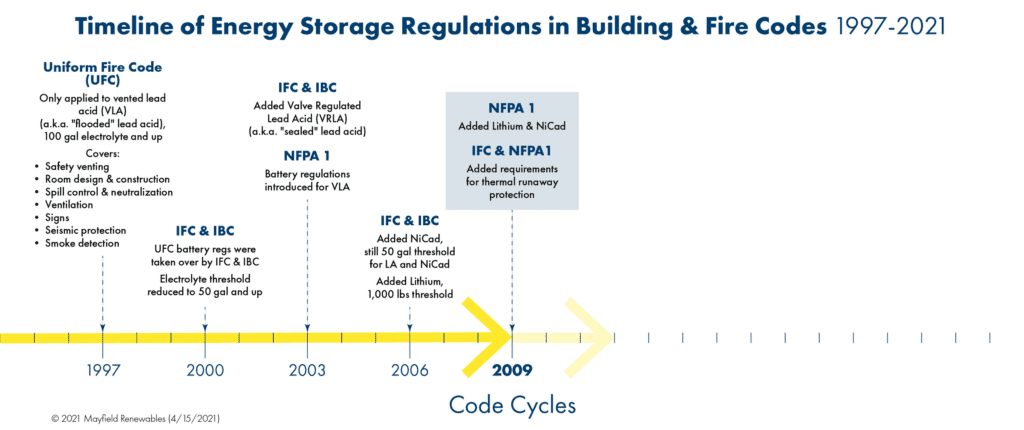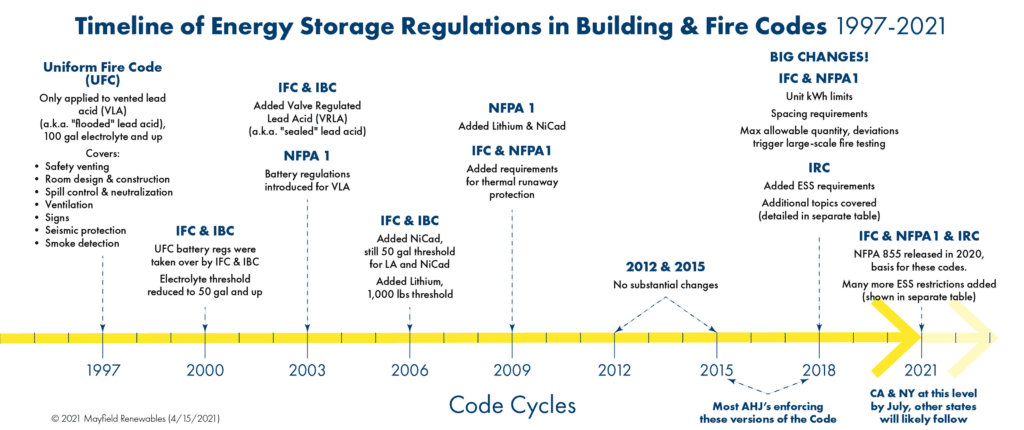Code Corner: Energy Storage Fire Codes Timeline
In this edition of our Code Corner series, we cover the energy storage fire codes timeline.
Looking at the history of the fire codes, which is provided as an annex in the NFPA 855 document, we can see that stationary energy storage is not a new topic—it has been covered by the Uniform Fire Code (UFC) since 1997. That’s 25 years of actual codes that have been implemented, although it was really only for commercial applications and only for vented (or flooded) lead-acid batteries. Back then, systems with a liquid capacity greater than one hundred gallons of electrolyte had to be regulated. The UFC identified hazards such as venting, occupancy separation, spill control, and seismic protection in the requirements. Room design and construction were also covered, so rooms that contained stationary storage systems had regulations around them, such as fire-resistive ratings within the walls. As NFPA 855 Annex F notes, the requirements were based on normal operation, and issues such as overcharging, thermal runaway, and other abnormal conditions were not considered.
For 25 years, we’ve had these rules in play for a specific chemistry and amount of electrolyte. Starting in 2000, what was then the Uniform Fire Code was split into the International Fire Code (IFC) and the International Building Code (IBC). The biggest change that occurred during this process was that the IFC reduced the amount of electrolyte that had to be regulated from 100 gallons down to 50 gallons. Since most of us don’t measure our batteries in terms of gallons, the equivalent is about 70 kWh of lead-acid batteries before these IFC requirements were in place. The components of the UFC pertaining to the roof construction were moved into the IBC.

In 2003, the IFC coverage expanded to include valve-regulated (sealed) batteries. For the first time, the NFPA 1 Fire Code, a different fire code pertaining to areas that don’t follow the IFC, also started covering energy storage systems. NFPA 1 used the same language and source for the requirements as the 2000 IFC.
In 2006, both the IFC and NFPA 1 added requirements for different battery chemistries, such as Nickel-Cadmium (NiCad) and Lithium-ion (Li-ion). Installations had to have at least 1,000 pounds (more than 50-100 kWh) of Li-ion batteries to be regulated. Why is there a range? Certain Li-ion battery chemistries are more energy-dense than others. For example, nickel magnesium cobalt (NMC) has a high energy density, so you need fewer pounds of it to create a certain kWh, but lithium iron phosphate (LFP) batteries would require more weight to create the same amount of kWh.

In 2009, the NFPA 1 added regulations to Li-ion batteries and NiCad batteries. This was also the first time that both the codes, IFC and NFPA 1, recognized the need for thermal runaway protection for Li-ion batteries. In 2009, 2012, and 2015, not many changes happened. Different parts of the country use different versions of the fire codes, and between 2009 and 2015, regulations for energy storage systems were essentially the same everywhere in the US.
In 2018, a few big changes occurred. That’s when we started seeing more energy storage system rules, such as a per-unit kWh limitation for each installed unit. The IFC wanted to regulate how closely we could put those units together, so they added requirements for minimum spacing between energy storage units. If an installer deviates from those rules, it triggers a large-scale fire test, which we know as UL 9540A, a topic for a separate article. Also of note in 2018 was the introduction of residential requirements for energy storage systems. Prior to 2018, there were no residential-specific requirements for energy storage systems, and in 2018 some minimal rules (such as “do not put these in habitable spaces”) were added.

Most authorities having jurisdiction enforce either the 2015 or the 2018 versions of the IFC and International Residential Code (IRC), but we have a new code cycle in 2021, which was adopted by some local jurisdictions. In 2021, the energy storage rules got much stricter, especially for installation methods. Another new document was released, the NFPA 855 Standard for the Installation of Stationary Energy Storage Systems, which contains much more energy storage information. The rules from NFPA 855 are the basis for the 2021 versions of the IFC, IRC, and NFPA 1. California and New York are leading the way on adopting the 2021 IRC and IFC codes, but other states are starting to adopt them as well. The new commercial rules are much more intense, and the residential rules are much deeper than they used to be too.
If you’re looking to dive deeper into fire codes for energy storage, you’re in the right place! We offer design and engineering services for ESS systems as well as educational courses such as live and recorded sessions on energy storage codes and the National Electrical Code to help professionals in the PV and solar-plus-storage industries.










